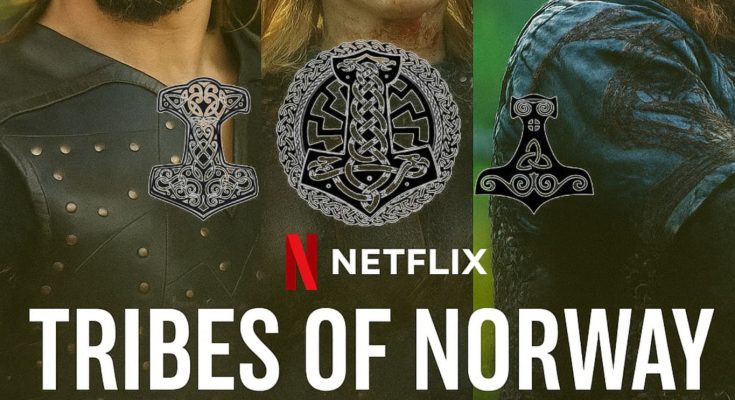Tribes of Norway: The Amalgamation – A Viking Epic of Blood, Unity, and Destiny
The tale of the tribes of Norway is one carved from ice, stone, and fire, a saga that speaks of men and women who endured the unforgiving land, where fjords cut deep into the earth like wounds from the gods and mountains rose as though guarding the very secrets of time. Out of this land of relentless winters, fleeting summers, and storms that seemed to echo with the voices of Odin and Thor, arose the Norse tribes, scattered and divided, yet destined to forge a unity that would shake the ancient world. “Tribes of Norway: The Amalgamation” is a Viking epic that dives into this story of blood, unity, and destiny, where battle was not just for survival, but for honor, power, and the very soul of a people who would one day carve their name into the chronicles of history.
The Norse tribes were many, fractured across valleys, coastal settlements, and rugged inland villages. Each clan believed themselves to be chosen by their gods, and each carried their own customs, leaders, and ambitions. Loyalty was as fierce as betrayal was swift, and kinship bonds often dissolved in the face of vengeance, greed, or the lure of foreign wealth. Yet beneath the endless raids, rivalries, and sagas of feuds, there ran a deeper current: the idea that the Norse were more than tribes, that together they might form something unbreakable, something destined. This notion, however, was not born of peace—it was forged in blood, in the clash of swords, and in the fire of the mead halls where skalds recited verses that spoke of gods demanding more from men.
At the heart of the amalgamation was the belief in fate—what the Norse called wyrd. To them, every man’s life was a thread woven by the Norns, the three sisters who shaped destiny. Warriors believed they fought not to change fate but to fulfill it, to meet the end the gods had written for them with courage and pride. When chiefs and jarls spoke of uniting the tribes, they did so not in the tongue of compromise but in the language of destiny, claiming that Odin himself willed for Norway to stand as one people, fierce and unconquered. But destiny demanded sacrifice, and the unification of the tribes would exact a price steeped in rivers of blood.
The first sparks of unity were born not from choice but from necessity. Coastal villages faced the relentless raids of foreign invaders, Danes and Saxons who sought to plunder the rich resources and trade routes of Norway. Though the Norse themselves were raiders feared across Europe, when the storm turned inward and foreign sails pierced their horizons, the scattered tribes began to realize that standing alone meant certain ruin. Leaders who once bickered over grazing rights or insults in the halls of kings now found themselves sitting across fire-lit tables, drinking from the same horns, and forging uneasy pacts. Yet these pacts were fragile, for the Viking spirit was not easily bent to submission, and the desire for dominance often eclipsed the necessity of cooperation.
Among the sagas told of this era is the story of a great assembly, a thing where chiefs gathered to decide whether to unite under a single banner. It was said the meeting nearly ended in slaughter, with accusations hurled like axes and old grudges flaring like wildfire. But then a skald rose and recited verses that spoke of Ragnarok, the twilight of the gods, and reminded them that even Odin, Thor, and Freyja would fall if they stood divided against the chaos to come. His words silenced the hall, and though many left unconvinced, the seed of amalgamation was planted in the minds of the tribes. They began to understand that their greatest enemies might not be across the sea but among themselves if they could not rise above division.
The road to unity was neither swift nor merciful. Brothers turned on brothers, villages burned, and countless warriors fell in battles that were as much about proving strength as about securing alliances. Each victory was paid for with sorrow, and each oath sworn was tested by betrayal. Yet through these crucibles of violence, a strange resilience grew. The tribes began to weave together not only through marriage and trade but through shared blood spilled in defense of their land. Warriors who once cursed each other’s names found themselves shoulder to shoulder on the battlefield, their shields locked, their voices raised in the same war cries. It was in the furnace of constant conflict that the identity of a unified Norway began to take shape.
The amalgamation was not simply political; it was spiritual. The Norse believed their ancestors watched from Valhalla, judging the deeds of the living. To forge unity was to honor the fallen, to prove that the sacrifices of generations were not squandered in petty feuds but carried forward into a greater purpose. Blood rituals, sacrifices to Odin, and sacred oaths at stone altars became the glue that held alliances together. Destiny was invoked at every turn, for the Norse needed to believe that the gods themselves approved of this dangerous path. Without divine sanction, no chieftain could hold together the restless spirit of his people.
Stories from this time tell of larger-than-life figures—chieftains who led with fire in their eyes, shieldmaidens who defied tradition to carve their place in history, and seers who whispered of a future where Norway would rise as one. These individuals became symbols of the destiny that the tribes could not ignore. When a great leader fell, his death was not seen as the end but as a sacrifice demanded by fate, a thread cut so that the greater tapestry might be woven. Their sagas spread across the land, binding people together with a shared mythology of blood and destiny.
The final stages of amalgamation came with the realization that unity was not only for defense but for conquest. The Norse had long looked outward, their dragon-headed ships striking terror along the coasts of Britain, Francia, and beyond. To unite the tribes was to unleash a storm upon the world, to take the fury of fragmented clans and transform it into a tidal wave of power. Chiefs began to see the advantage of standing under a single king, for while independence was cherished, the spoils of greater victories beckoned. It was not only about survival—it was about carving a destiny so immense that the world itself would remember the name of Norway.
And so, through fire, steel, and sacrifice, the tribes of Norway became more than clans—they became a nation. The amalgamation was never clean, never free from bloodshed, but it was inevitable. It was written in the stars, in the whispers of the Norns, and in the hearts of men and women who knew that destiny favored the bold. Unity did not erase the fierce individuality of the Norse; rather, it magnified it, binding together a people whose ferocity was unmatched, whose spirit was unbreakable, and whose belief in destiny carried them beyond the edges of the known world.
“Tribes of Norway: The Amalgamation” is thus not merely a story of politics or war—it is a saga of transformation. It is about how a scattered people found strength in their shared blood, how they learned that unity was not weakness but the ultimate weapon, and how destiny demanded they rise together or fall apart. It is a tale drenched in the mead of celebration and the tears of loss, a tale where every battle, every betrayal, and every oath contributed to the forging of something greater than any tribe alone could have achieved. The Norse tribes understood, in the end, that while men may die, a united people could endure, their legacy echoing through centuries as the foundation of a nation and the inspiration for legends yet to be told.
In this way, the amalgamation of the tribes of Norway stands as one of the great Viking epics, a saga of blood, unity, and destiny. It is a reminder that even in the harshest lands, even among the fiercest of warriors, the path to greatness lies not in standing alone but in standing together, bound by blood, driven by destiny, and forever etched into the eternal song of history.



